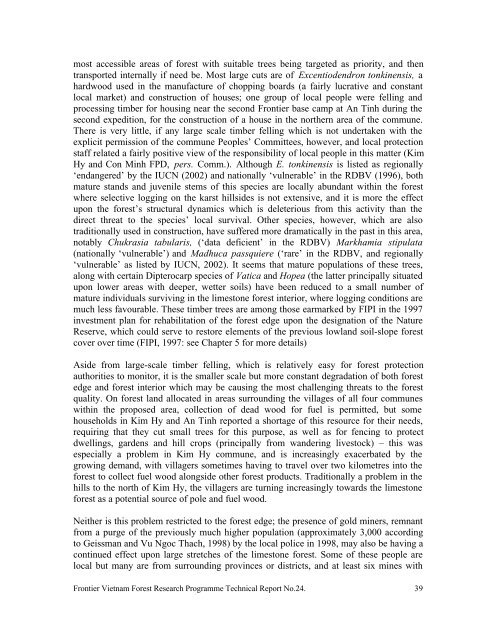Kim Hy Proposed Nature Reserve - Frontier-publications.co.uk
Kim Hy Proposed Nature Reserve - Frontier-publications.co.uk
Kim Hy Proposed Nature Reserve - Frontier-publications.co.uk
Create successful ePaper yourself
Turn your PDF publications into a flip-book with our unique Google optimized e-Paper software.
most accessible areas of forest with suitable trees being targeted as priority, and then<br />
transported internally if need be. Most large cuts are of Excentiodendron tonkinensis, a<br />
hardwood used in the manufacture of chopping boards (a fairly lucrative and <strong>co</strong>nstant<br />
local market) and <strong>co</strong>nstruction of houses; one group of local people were felling and<br />
processing timber for housing near the se<strong>co</strong>nd <strong>Frontier</strong> base camp at An Tinh during the<br />
se<strong>co</strong>nd expedition, for the <strong>co</strong>nstruction of a house in the northern area of the <strong>co</strong>mmune.<br />
There is very little, if any large scale timber felling which is not undertaken with the<br />
explicit permission of the <strong>co</strong>mmune Peoples’ Committees, however, and local protection<br />
staff related a fairly positive view of the responsibility of local people in this matter (<strong>Kim</strong><br />
<strong>Hy</strong> and Con Minh FPD, pers. Comm.). Although E. tonkinensis is listed as regionally<br />
‘endangered’ by the IUCN (2002) and nationally ‘vulnerable’ in the RDBV (1996), both<br />
mature stands and juvenile stems of this species are locally abundant within the forest<br />
where selective logging on the karst hillsides is not extensive, and it is more the effect<br />
upon the forest’s structural dynamics which is deleterious from this activity than the<br />
direct threat to the species’ local survival. Other species, however, which are also<br />
traditionally used in <strong>co</strong>nstruction, have suffered more dramatically in the past in this area,<br />
notably Ch<strong>uk</strong>rasia tabularis, (‘data deficient’ in the RDBV) Markhamia stipulata<br />
(nationally ‘vulnerable’) and Madhuca passquiere (‘rare’ in the RDBV, and regionally<br />
‘vulnerable’ as listed by IUCN, 2002). It seems that mature populations of these trees,<br />
along with certain Dipterocarp species of Vatica and Hopea (the latter principally situated<br />
upon lower areas with deeper, wetter soils) have been reduced to a small number of<br />
mature individuals surviving in the limestone forest interior, where logging <strong>co</strong>nditions are<br />
much less favourable. These timber trees are among those earmarked by FIPI in the 1997<br />
investment plan for rehabilitation of the forest edge upon the designation of the <strong>Nature</strong><br />
<strong>Reserve</strong>, which <strong>co</strong>uld serve to restore elements of the previous lowland soil-slope forest<br />
<strong>co</strong>ver over time (FIPI, 1997: see Chapter 5 for more details)<br />
Aside from large-scale timber felling, which is relatively easy for forest protection<br />
authorities to monitor, it is the smaller scale but more <strong>co</strong>nstant degradation of both forest<br />
edge and forest interior which may be causing the most challenging threats to the forest<br />
quality. On forest land allocated in areas surrounding the villages of all four <strong>co</strong>mmunes<br />
within the proposed area, <strong>co</strong>llection of dead wood for fuel is permitted, but some<br />
households in <strong>Kim</strong> <strong>Hy</strong> and An Tinh reported a shortage of this resource for their needs,<br />
requiring that they cut small trees for this purpose, as well as for fencing to protect<br />
dwellings, gardens and hill crops (principally from wandering livestock) – this was<br />
especially a problem in <strong>Kim</strong> <strong>Hy</strong> <strong>co</strong>mmune, and is increasingly exacerbated by the<br />
growing demand, with villagers sometimes having to travel over two kilometres into the<br />
forest to <strong>co</strong>llect fuel wood alongside other forest products. Traditionally a problem in the<br />
hills to the north of <strong>Kim</strong> <strong>Hy</strong>, the villagers are turning increasingly towards the limestone<br />
forest as a potential source of pole and fuel wood.<br />
Neither is this problem restricted to the forest edge; the presence of gold miners, remnant<br />
from a purge of the previously much higher population (approximately 3,000 ac<strong>co</strong>rding<br />
to Geissman and Vu Ngoc Thach, 1998) by the local police in 1998, may also be having a<br />
<strong>co</strong>ntinued effect upon large stretches of the limestone forest. Some of these people are<br />
local but many are from surrounding provinces or districts, and at least six mines with<br />
<strong>Frontier</strong> Vietnam Forest Research Programme Technical Report No.24. 39
















